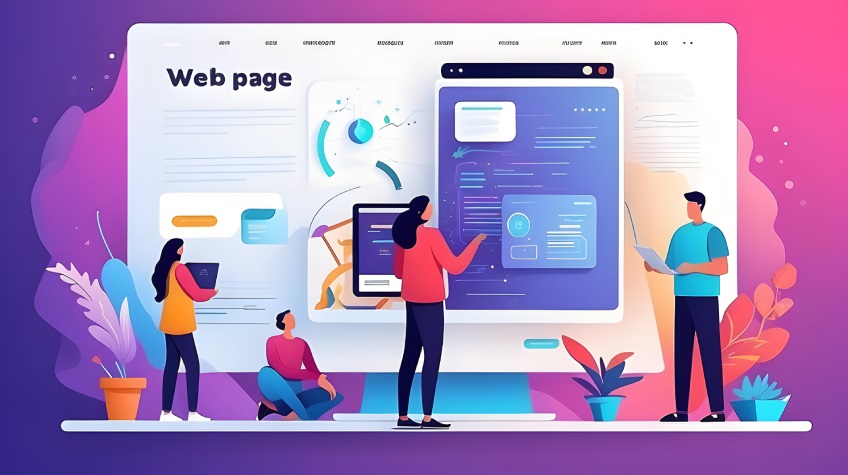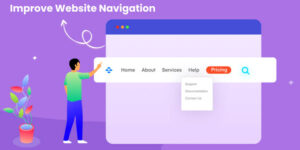
Introduction
Welcome, dear readers! We’re kicking off our exploration of the intertwined world of business and technology, and what could be a better starting point than discussing the impact of good website design on business success. Whether you’re a thriving entrepreneur or just starting up, you’ll find out how critical an impressively designed website can be for your progress.
⇰ Importance of Website Design for Business Success
Great web design is far from mere aesthetics. It also encompasses site usability, user experience, and a whole lot more, acting as a powerful tool for businesses to increase their engagement and conversions. Investing in good website design not only helps companies to stand out from their competitors but also builds their brand identity.
⇰ Brief Overview of the Impact of Good Website Design on User Experience, Conversion Rate, and Customer Engagement
Optimizing for user experience leads to repeat visits and referrals via word of mouth and social media. On the other hand, for increased conversion rates, web design should incorporate clear calls-to-action, compelling and easy-to-understand information about products and services, and simplified checkout processes.
- A well-laid-out, visually appealing website encourages users to stay longer, thus increasing customer engagement.
- Eye-catching and relevant images, especially stock images of people, tend to generate a sense of trust among potential clients.
- Good website design ensures a trouble-free, enjoyable user experience, leading to positive reviews and higher customer retention rates.Indeed, a well-designed website can make all the difference when it comes to the growth and success of your business. So, let’s dig deeper into this crucial topic!
The Connection Between Website Design and User Experience
Understanding this link is crucial in getting to grips with how website design can impact business success. Let’s delve into this a little further.
⇰ Definition of User Experience (UX)
User Experience, often abbreviated as UX, is a term that encompasses all aspects of a user’s interaction with a company, its services, and its website. It’s about meeting the user’s needs in the most effective and enjoyable way possible. A high-quality UX promotes user engagement and satisfaction, ultimately fostering a higher conversion rate for businesses.
⇰ How Good Website Design Contributes to a Positive UX
A well-designed website puts its users first by having an easy-to-follow layout, intuitive navigation, and great content. When users can quickly find what they’re looking for, their experience is vastly improved. This, in turn, can lead to a positive impression about your brand and increased trust, which often results in higher return rates and conversions.
⇰ Examples of Effective Website Design Elements that Enhance UX
- Clarity of content: Your content needs to be easily digestible and meaningful to the user. Using headings, subheadings, bullet points, and infographics can help simplify complex information.
- Consistent branding: Users should instantly recognize your brand on every page of your website. Inconsistencies can make users question your professionalism and reliability.
- Mobile optimization: The design should adapt seamlessly to different screen sizes to cater for our increasingly mobile world. A responsive design ensures satisfactory experiences on all devices.
- Loading speed: A site that loads quickly improves the user experience and goes a long way in retaining a user’s interest.In a nutshell, a good website design directly influences user experience and therefore impacts the rate of business success.
Enhancing Conversion Rates through Good Website Design
Web design doesn’t just add aesthetic appeal, it’s a crucial determinant of your business’s conversion rates. The connection between how your website looks and functions and the success of your business might be more significant than you think. Let’s explore why.
➥ Definition of Conversion Rate and its Significance in Business Success
By definition, the conversion rate is the percentage of visitors to your website who complete a desired action like making a purchase or signing up for a newsletter. It’s one of the most vital measurements of business success because it directly affects your profitability. A high conversion rate means that your website visitors are finding what they need and want. This can signal a successful website design and effective marketing strategy.
➥ How Good Website Design Can Improve Conversion Rates
A good website design can significantly boost your conversion rates. How?
- Easy navigation: Visitors should be able to find exactly what they’re looking for without frustration.
- Clear call-to-action: Guide your visitors towards taking the action you want.
- Pleasing visuals: Good design, including professional photos or stock images of people, intertwined with your brand’s aesthetics, help in catching and retaining the visitor’s attention.
➥ Case Studies and Examples of Businesses That Benefited from Good Website Design to Increase Conversions
Many businesses have experienced a significant uplift in their conversion rates after investing in better website design. For instance, the travel booking site “Booking.com” revamped their website design making it more intuitive and easier to navigate, consequently seeing an increase in conversions. Lastly, the designer clothing retailer “ASOS” reshaped their mobile app design which has contributed significantly to their digital growth. Data tells us that good web design isn’t just about looks, but it’s a crucial component of a successful business.
Increasing Customer Engagement with Good Website Design
Engaging customers is vital to a thriving business. A well-designed website can provide a platform that encourages customer interaction, facilitates dialogues, and fosters personalized connections.
➥ Importance of Customer Engagement for Business Success
Customer engagement is the heartbeat of a successful business. Active engagement often results in:
- Long-term customer loyalty
- Increased customer satisfaction
- Repeat business and referrals
- Positive word-of-mouth marketingThese factors cumulatively play a significant role in boosting business growth and profitability.
➥ How Good Website Design Can Engage Customers
A good website design is more than just stunning visuals. It’s about crafting an enjoyable user experience— intuitive navigation, rich content, easy-to-use features, and impactful calls-to-action. For instance, using relevant stock images of people can make your website more personal and engaging. Through this, customers naturally spend more time on your site, increasing the likelihood of conversion.
➥ Strategies and Techniques to Design a Website That Promotes Customer Engagement
Creating an engaging website is a delicate balance of knowing what your customer wants and expressing your brand’s personality effectively. Here are a few key strategies:
- Consistent and professional branding
- Intuitive and user-friendly navigation
- Engaging, up-to-date, and valuable content
- Effective use of visuals, including colors, icons, and high-quality stock images of people
- Offering interactive elements, such as chatbots, forms, polls, quizzesIn conclusion, a well-designed website is a powerful tool in fostering customer engagement, which in turn drives business success.
The Role of Responsive Design in Business Success
Responsive Design is no longer a luxury, it’s a critical element that can make or break your business’s online presence. Let’s delve a little deeper to understand its essence and its role in business success.
➪ Definition and Explanation of Responsive Web Design
Responsive web design is a web development approach that creates dynamic changes to the appearance of a website, depending on the screen size and orientation of the device being used to view it. In simple terms, it enables websites to fit the screen of any device seamlessly, providing an optimal viewing experience across a wide array of devices – from desktop computers to smartphones and tablets.
➪ Benefits of Responsive Design for User Experience and Conversion Rates
But why does this adaptability matter? Here are a few reasons:
- It enhances user experience: A user-friendly website means visitors can find what they’re looking for quickly and easily, which leads to longer stays and more engagement.
- Improved conversion rates: When a user has a positive experience on your website, they are more likely to convert, whether that conversion means making a purchase, filling out a form, or any other desired action.
➪ Importance of Mobile-Friendly Websites for Business Success in Today’s Digital Landscape
In this rapidly evolving digital landscape where more than half of all web traffic comes from mobile devices, having a mobile-friendly website isn’t just important, it’s essential for business success. If your website isn’t optimized for mobile, you’re likely to lose out on a significant chunk of potential customers. An excellent responsive design will ensure you keep those customers and, more importantly, keep them coming back.
Optimizing Website Design for SEO and Search Engine Rankings
Search engines serve as the gateway to the digitally vast universe of the internet. A well-designed website not only captures the user’s attention but also helps in increasing visibility in search engine results. By improving SEO and search engine rankings, it’s a tool that can attract a huge number of visitors, leading to high conversion rates.
➪ Overview of Search Engine Optimization (SEO)
Search Engine Optimization (SEO) refers to the practice of improving a website to increase its visibility when people search for products or services related to your business in Google, Bing, and other search engines. The higher your website ranks in the search engine results pages (SERPs), the more likely you are to garner attention and attract prospective and existing customers to your business. Hence, SEO becomes a critical aspect of successful online business.
➪ How Good Website Design can Improve SEO and Search Engine Rankings
A user-friendly website with clear navigation, high-quality content, relevant stock images of people, and a seamless design all play an important role in improving SEO and search engine rankings. Good website design implies low bounce rates, higher time spent by users on your site, and consistently high traffic, all of which are factors improving your SERP rankings.
➪ Tips and Best Practices to Optimize Website Design for Better SEO Performance
- Include Relevant Keywords: Insert relevant keywords throughout your website content, including titles, descriptions, and body text.
- Mobile Friendly Design: Make sure your website is mobile-friendly since a majority of searches are done through mobile devices.
- Fast Loading Speed: A site that loads quickly enhances the user experience and is favored by search engines.
- Use of Alt Text for Images: Always use alt text for images to help search engine crawlers better understand the graphics on your website.
- Quality Backlinks: Try to build quality backlinks as search engines view them as a vote of confidence in your content.By implementing these practices, you can optimize your website design for better SEO performance, which indirectly contributes to higher user engagement, better conversion rates and overall business success.
The Impact of Website Design on Branding and Business Reputation
Understanding the effect of website design on branding and business reputation can significantly influence your company’s success. Let’s delve in!
➭ Importance of Branding and Reputation for Business Success
Simply put, your brand tells your story. It’s your unique business identity that differentiates you from your competitors. Customers want to do business with companies they recognize, trust, and feel good about. That is where the reputation steps in. A positive reputation builds customer loyalty and trust, which leads to business growth. Therefore, cultivating a strong brand and maintaining a good reputation should be a top priority for every business.
➭ How Good Website Design Can Enhance Branding and Business Reputation
A well-designed website signals competence, professionalism, and commitment to quality, thus creating a positive impression of your business. Good website design includes:
- High-quality visuals, including stock images of people that reflect your target audience
- User-friendly navigation that aids in customer engagement
- Cohesive color schemes and fonts that align with your brand identity Each of these elements aids in presenting a unified, consistent brand image that visitors will remember and trust.
➭ Case Studies and Examples of Businesses That Improved Their Branding Through Website Design
Consider the inspiring example of Apple. Their minimalist, user-friendly website design mirrors their sleek product designs. By ensuring their website design is consistent with their overall brand, they’ve created a strong, recognizable online presence that contributes to their notable business success. Another example is Airbnb. Their website’s intuitive design, beautiful images of homes, and authentic reviews foster trust and comfort, reflecting their core brand values. These examples highlight just how powerful good website design can be in bolstering a business’s reputation and brand image.
Conclusion
➭ Summary of the impact of good website design on business success
In a nutshell, investing in a good website design is not merely about making your platforms aesthetically pleasing but it significantly steers your business to success. From enhancing user experience, increasing conversion rates to augmenting customer engagement, every tiny detail contributes to the overall business outcome. It grants your business a broader digital footprint, and with a carefully constructed website that uses strategic keywords like “stock images of people,” your business can reach the loftiest peaks of Search Engine Optimization (SEO).
➭ Reminder of the key elements to consider for effective website design
Remember, a successful website design takes into account the following:
User Experience: Your site should be easy to navigate, accessible, and improve customer interaction.
Conversion Rate: Make sure your website is optimized to drive visitors to complete a desired action.
Customer Engagement: Use engaging and attractive content like stock images of people to attract and retain visitors.
➭ Call-to-action for businesses to invest in good website design for long-term success
Now, is your business ready to take a step forward? Let’s say ‘Yes’ to adopting high-standard website design that can transform your business and set it up for long-term success. Remember, in today’s digital world, your website is often a customer’s first impression of your business. So, make it count! Turn your visitors into loyal customers with an appealing, efficient, and effective website design.






